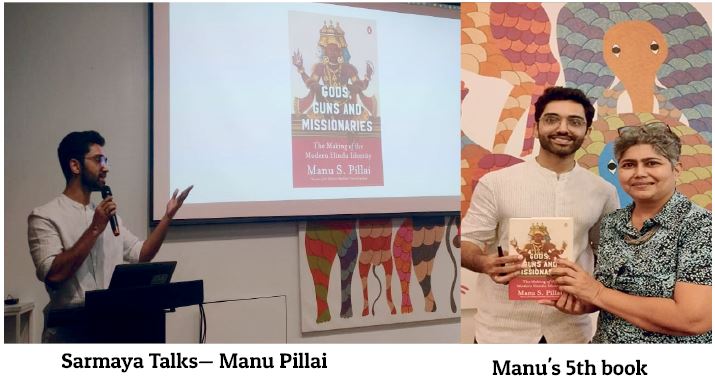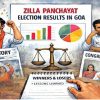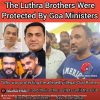Goa is abuzz with excitement as vintage bike and car owners, users, collectors and fans are decking […]

BEING TOO WOKE IS EXTRA WORK!By Joanne Pinto Pereira
Dec 14- Dec 20 2024, JO-GO ART December 13, 2024
FOUNDER of Sarmaya Arts Foundation, Paul Abraham’s dream of their own space for Sarmaya saw fruition. It’s sheer transformation in the heritage area. Pavitra has outdone her Pavitra Rajaram design architectural practise to restore the concealed teak ceiling to its original glory. If I remember well, the space was a cramped property department for Grindlays before its merger with Standard Chartered. The PaPa power couple have complemented their passion to create magic and it’s remarkable news for the art world.
I am glad that I came in so early to the new space of Sarmaya, at the almost sesquicentennial Lawrence & Mayo Building, for the first of the Sarmaya Talks there. The massive Jangarh Singh Shyam that greets us, is the piece de resistance amidst towering walls of precious books. I meet Susan (Sue) Sharma (who I hand-hold literally on the adventure front path outside the building) and we lose track of time as we converse about Manu Pillai’s books and her friend’s digital arrest.
Sarmaya Talks
WHEN Manu speaks you listen. “Gods, Guns and Missionaries” is the fifth of his books and very different from the earlier four, namely “The Ivory Throne” (2015), “Rebel Sultans” (2018), “The Courtesan, the Mahatma and the Italian Brahmin (2019) and “False Allies” (2021).
It’s a topic that could get prickly. All the more reason for his over a decade of research. You keep sight of the overview, the attempt to meticulously record history to understand our present-day civilisation. The past as it appears in Manu’s book is more complicated than popular narratives allow.
Mutual respect for perspectives requires an open mindset as we evolve as a society. Mom’s maternal cousin was the founder of XLRI Jamshedpur and the Goa Institute of Management, a Jesuit who was honoured with a Padma Shri and is regarded as the Father of Management in India. The other priest cousin among others in the field of education had done his doctorate on the Upanishads while the gentle Director of Nirmala Niketan chose textiles. Stereotypes are indeed kept alive and result in a lot of distortion.
Dialogue and historical repositories are vital for societies that acquire maturity. The capacity to accept the permanence of history and its rich diversity is a learning envisioned. The Puranas carry a treasure chest. Are you willing to pick the best of our civilisations and bury the worst? Invariably the interpretations of time, context and intent, have given slants to our existence. Are we willing to move forward?
Paradoxically,it was the colonial infrastructure and education including the translation of the Gita to English that got the concept of Hinduism its identity.

Rebirth
MY instincts gravitate to the Goa-based Nikhil Chaganlal’s exhibition at Art Musings. These are Songs of Rebirth of an artist who has embraced his chosen land of belonging. His work depicts paradise found with childlike wonderment (just before the pandemic when your surroundings became an extension of your mind space). Fresh from a lot of Souza viewing, particularly his early works of the landscape of Goa, the influence in Nikhil’s works is clear as daylight. Nikhil acknowledges it and artists like Manu Parekh who influenced his artistic style. His canvas captures what the seeing eye beholds.
A veil of branches that frame a church or edifice, ablaze with colour, brilliant as the Gõychem maati (the bright red mud of Goa). Each sub-frame holds the coupling of nature and architecture, distinct with the strong black lines that he has made his own.
He is known to paint at night which explains the luminosity of his work. The details and nuances of daily life in Goa, a bird, the cock atop the roofs, water bodies alight with sun rays. They are touches reminiscent of my Loutlekar, the late Mario de Miranda, invariably included in his work. It carries the freshness of someone viewing the obvious, anew. Of the Goa I knew and is gradually being eroded of its idyllic fabric.
Nikhil’s subject is best summed by the words of another centennial, Nissim Ezekiel, Bombay’s much loved poet who Ranjit Hoskote quotes to introduce “Rebirth.”
“…The slow movement seems, somehow, to say much more.
To watch the rarer birds, you have to go
Along deserted lanes and where rivers flow……”
There is a sense of rich goodwill in the bustling preview. Gallerist Shanti Chopra’s warmth makes me quip, “The space is Art Home Musings, not just a gallery.” It delights her and she rewards me with a shayaar. Earlier I managed to squeeze “Stain Canon” at XXL and its youthful vibe. The space has a steady stream of curations off the beaten track. More about it later.
BUY NOW!
I TRY to keep my carbon footprint low. Not great at it and it does create clutter and angst in our Mumbai flats. I try! Mindful consumption is not just all the ‘Rs that being with Recycle, Repair. It’s saying NO to the purchase in the first place. Why can’t we make less and give the consumer a product that lasts? A starting point is to understand how deviously the excess production for profit has spiralled into waste for profit. Can you say NO to the insane deals that propel you to BUY NOW!?
I am happy to say art has kept me so happily engaged, I’m almost back to slow living. Those evil earplugs and black Fridays are enslavers! Are you going to let that pixel take charge of your contribution to garbage generation? More importantly, unleash the monster of climate change? The Netflix film is a purse zipper! You are being hypnotised by “Creative Interpreters of the Truth.” Green washing companies that pretend to care. RUN in the opposite direction!! I wish we had more like this to watch #reality #shoppingconspiracy #endofcycle #lyinglabels #YouRaLiar #ControlNoMore #HideNoMore #Change #Choices #BuyLess #mindfulconsumption #carbonfootprint #sayno

NCPA@ The Park
THE Bandra Amphitheatre is the perfect space to soak in the best of the season. The SOI has provided a great platform to showcase fresh talent ably flanked by its seasoned musicians. Francis Mendes has been one dedicated string musician with his viola. A cross-section representative of their repertoire like K Jenkins “Palladio,” apart from the lively classics (Mozart, Shostakovich, Vivaldi), tangos and the festive Christmas medley. It almost makes you want to get up and dance. The entire place is dressed up for the season including Damian’s window if you want to walk up to Land’s End.
It’s Raining Textile Art
AND that is something to celebrate. “The Woven Path,” curated by Sharan Apparao, at Space 118 is a revelation for even diehard art stalkers. I got to know of Sharan, some years back, as the person whose doors were open to artists looking for a place to stay even when she was not in the country. Based out of Chennai, it would be truthful to say the lady has been a pillar of support for a lot of artists on their way up. Her instinct is what good art is about.
The exhibition features a range of contemporary textile/fibre-based artworks from the Saloni Doshi Collection. These include works by artists like Anju Dodiya (I still recollect her as part of BDL’s 2018 textile exhibition along with Reena Kallat), Jayeeta Chatterjee, Varunika Saraf, Arshi Ahmadzai, Viraj Khanna and many more).
Space 118 is a discovery in itself. Saloni housed residencies for artists and encouraged the sale of their artworks, particularly during the pandemic. The curation is placed in each tiled roofed studio.
Studio 1 – “The Source” has two up-cycled leather collages by Mithun Das. Studio 2 themed “Crystallisation” has two works by Sabiha Dohadwala (1995) which stole my heart. The artworks have openings in the Latin American hand-woven tradition titled “Crammed Between the Cracks 2024.” While she attempts to capture memories and histories in her work, the gaps are meant to release the soul that gets immersed in the work. I would like my soul to be stilled in such a beautiful work. Studio 3 has Deena Pandoria’s (1991) narrative taking us to her roots in Kutch and Jayeeta Chatterjee whose trajectory has zoomed since her showing at Chemould Collab.
Studio 4 has “Transformation.” Here you have Varunika’s embroidered blue and yellow canvas with her signature political commentary, the voice of an artist who is aware which was visible at her installation for the Chemould 60th. It reminds me of Ghulam Mohammed’s “Karwan” at Chemould Prescott.
Also, the floor wears Neda Razavipour’s “Self-Service” — a piece of history, a tapestry, which is best viewed in person. The Fifth studio is devoted to Kutch embroidery. The standout here has to be the prints of Ravi Varma’s printing press embellished with zardozi. My grandmother did intricate embroidery and appliqué work around sacred pictures and those of her children’s milestones.
In our world of waste, it is so heartening to see up-cycled work. It takes me back to an era where there was no waste.
Give Us This Day A Roof Above Our Head
GIRISH Shahane speaks for those who call the city Bombay and introduces Anjana Mehra’s “Four Walls One Square Foot A Piece Of Sky” at Nine Fish in collaboration with Dotline Space. Anjana has put her significant struggle in her canvases including the court agreement pieces bearing her name. Those who know her recollect how she stayed confined to her house to prevent her from being homeless. The urban malaise is now in every breath you take or rather struggle to take.
On view till January 4, 2025















